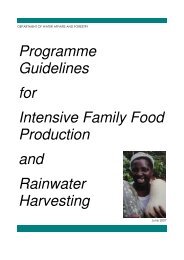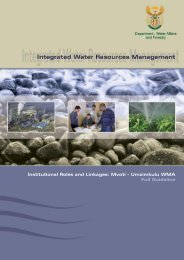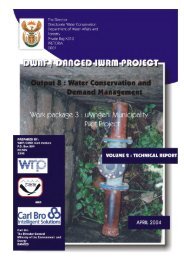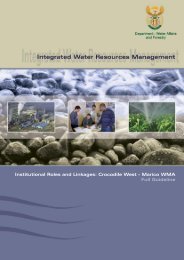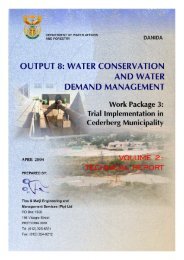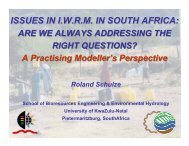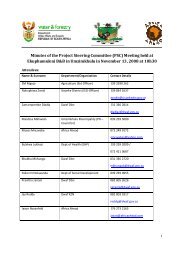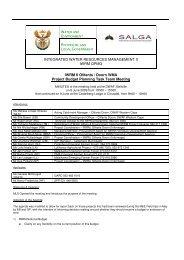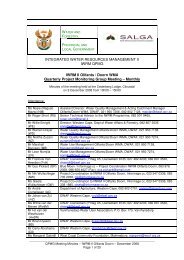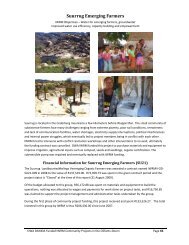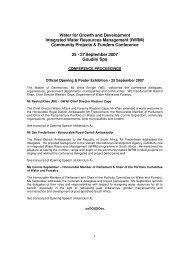Create successful ePaper yourself
Turn your PDF publications into a flip-book with our unique Google optimized e-Paper software.
FLIPCHART 8: Appropriate technology<br />
FLIPCHART 8: Ubuchwepheshe obufanele<br />
Message: understanding different sanitation technologies<br />
Umyalezo: ukuqonda ubuchwepheshe obuhlukene benhlanzeko<br />
Notes to facilitator<br />
The participants can look at the pictures and choose two types of sanitation systems to discuss.<br />
1. The Ventilation Improved Pit (VIP) toilet<br />
a. What is a VIP toilet and how does it work<br />
b. Where is this type of system found What are its main advantages<br />
c. What costs are involved with building a VIP<br />
d. Who bears the cost of building the toilet<br />
e. Who is responsible for the maintenance and cleaning of the VIP toilet<br />
f. How do you clean the VIP toilet What happens when the toilet pit is full<br />
Possible answers:<br />
a. Consists of an underground pit lined with cement. A concrete platform built over the pit stops the rain getting in and the side walls from<br />
collapsing. Air flows into the pit through a hole at the top and out through a narrow pipe at the back of the toilet. A flyscreen (wire mesh to<br />
keep flies in) is placed over the top of the pipe. Bacteria breaks down the waste as it builds up in the pit.<br />
b. Found mainly in informal settlements and rural areas where there is no water-borne sewerage system. Many school toilets in the rural areas<br />
are VIPs. Main advantages: cheap to maintain and don’t use water.<br />
c. Costs involved: building materials (doors, pipes, fly screen, toilet bowl, etc.), labour and emptying of the pit.<br />
d. Basic infrastructure provided by government through Municipal Infrastructure Grant (MIG).<br />
e. Householder is responsible for labour in the initial construction and maintaining the toilets and keeping them clean.<br />
f. Floors and seat can be cleaned with detergent but don’t put jik or bleach into the pit or it will kill the bacteria. Toilet paper is the only item that<br />
can go into the pit. Other items prevent bacteria from working and also quickly fill up the pit. Householders can empty the pit themselves or<br />
pay for the waste to be removed by a tanker truck. Another option is to dig another pit, move the top structure and place it over the new pit.<br />
2. Septic tank toilet system<br />
a. How does the septic tank system work<br />
b. When is it appropriate to have a septic tank<br />
c. What costs are involved with building a septic tank and who bears these costs<br />
d. How do you clean the toilet Who is responsible for maintenance and cleaning<br />
e. How do you clean the toilet Does the tank ever need to be emptied<br />
Possible answers:<br />
a. Like any other flush toilet above the ground, but when you flush it, water washes the waste material through a short pipe into an underground<br />
tank near the toilet. The waste stays in the tank but, as it fills up, extra liquid is forced out of the tank into an outlet pipe. The outlet pipe is either<br />
joined to a sewer or to a soak-away trench.<br />
b. Appropriate when you don’t have access to a waterborne system.<br />
c. Costs: building materials, labour and emptying the tank. The householder is responsible for all the costs.<br />
d. Householder is responsible for maintenance and cleaning.<br />
e. Rules for cleaning same as for VIP and UD. Special equipment is needed to empty the tank when it gets too full. This is called de-sludging. A<br />
private contractor must be hired to remove the waste through the top of the tank.<br />
3. Water borne sewerage system<br />
a. How does the water-borne sewerage system work<br />
b. Where are water-borne sewerage systems mainly used<br />
c. What costs are involved with building this system and who bears them<br />
d. Who is responsible for the maintenance and cleaning of water-borne sewerage system toilets<br />
e. What happens to the sewerage that gets washed out of the toilets Where does it go Who is responsible for cleaning sewerage<br />
Possible answers:<br />
a. Toilet is connected to a system of pipes underground. Above the ground it has a toilet bowl, seat and lid as well as a flushing system with a<br />
cistern. When you flush the toilet, water is pushed from the cistern into the toilet bowl to wash the waste material out through the underground<br />
pipes to a sewerage disposal plant some distance away.<br />
b. Waterborne systems are found in urban areas where there is access to the appropriate infrastructure.<br />
c. Costs involved are building materials, labour and disposal and treatment of the sewerage. The householder bears all these costs, either<br />
directly or through the payment of rates to the council.<br />
d. The householder is responsible for maintaining the toilets and keeping them clean. Any maintenance outside private property is managed by<br />
the Council at no extra cost to the householder.<br />
e. Sewerage goes to a sewerage disposal plant where it is cleaned and recycled. The council is responsible for cleaning the sewerage but this<br />
service is paid for by householders’ rates.<br />
© MiET Africa and Africa!Ignite 2007<br />
Amanothi omuntu osizayo<br />
Abantu ababambe iqhaza bangabuka izithombe bese bekhetha izinhlobo ezimbili zezinhlelo zenhlanzeko abazoxoxa ngazo.<br />
1. Ithoyilethi Elinomgodi Elingenisa Umoya Ngendlela Eyenziwe Ngcono (VIP)<br />
a. Lisebenza kanjani ithoyilethi i-VIP<br />
b. Lutholakala kuphi lolu hlobo lohlelo Yini enhle kakhulu ngalo<br />
c. Yiziphi izindleko ezibandakanyeka ekwakhiweni kwe-VIP<br />
d. Ubani othwala izindleko zokwakhiwa kwethoyilethi<br />
e. Ubani obhekana nomsebenzi wokunakekelwa kanye nokuhlanzwa kwethoyilethi i-VIP<br />
f. Ulihlanza kanjani ithoyilethi i-VIP Kwenzekani uma umgodi wethoyilethi usugcwele<br />
Izimpendulo ezinokutholakala:<br />
a. Linomgodi ongaphansi ofakwe usimende. Usimende owakhelwe emgodini uvimbela ukuthi imvula ingangeni futhi amacala engaweli phakathi. Umoya<br />
ungena emgodini ngembobo ephezulu bese uphumela ngaphandle ngepayipi elincane elingemuva kwethoyilethi. Isikrini sokuvimbela izimpukane (isisefo<br />
esincane sokuvimbela izimpukane) sibekwa phezu kwepayipi. Amagciwane abolisa amakaka uma elokhu anda emgodini.<br />
b. Atholakala kakhulu ezindaweni zokuhlala eziyimikhukhu kanye nasemakhaya lapho okungekho khona uhlelo lwamanzi lokuhambisa indle. Amathoyilethi<br />
amaningi ezikoleni ezindaweni zasemakhaya angama-VIP. Ubuhle obukhulu: kulula ukuwanakekela futhi awasebenzisi amanzi.<br />
c. Izindleko ezibandakanyekayo: izinto zokwakha (izivalo, amapayipi, isikrini sezimpukane, isihlalo sasethoyilethi, njll.), umsebenzi kanye nokuthulula<br />
umgodi.<br />
d. Ingqalasizinda eyisisekelo enikezelwa nguhulumeni ngokusebenzisa Usizo Lwengqalasizinda Lukamasipala (Municipal Infrastructure Grant (MIG)).<br />
e. Umnikazi womuzi ubhekene nomsebenzi ekwakhiweni kokuqala bese enakekela amathoyilethi nokuwagcina ehlanzekile.<br />
f. Phansi kanye nezihlalo kungahlanzwa ngesibulali magciwane kodwa ungafaki ijikhi noma ibhlishi emgodini ngoba izobulala amagciwane. Iphepha<br />
lasethoyilethi yilona kuphela elingangena emgodini. Ezinye izinto zivimbela ukusebenza kwamagciwane futhi zisheshe zigcwalise umgodi. Abanikazi<br />
bomuzi bangazikhiphela bona amakaka ethoyilethi noma bakhokhele ukuthi amakaka akhishwe iloli elinethangi lokukhipha amakaka. Enye indlela<br />
ukumba omunye umgodi, ususe isakhiwo esiphezulu usibeke emgodini omusha.<br />
2. Uhlelo lwethoyilethi lwethangi lokubolisa indle (Septic tank toilet system)<br />
a. Lusebenza kanjani uhlelo lwethangi elibolisayo<br />
b. Kunini lapho okufanele khona ukuthi ube nethangi elibolisayo<br />
c. Yiziphi izindleko ezibandakanyekayo ekwakheni ithangi elibolisayo futhi ubani othwala izindleko<br />
d. Ulihlanza kanjani ithoyilethi Ubani obhekana nomsebenzi wokulihlanza nokulinakekela<br />
e. Ulihlanza kanjani ithoyilethi Ingabe ithangi like lidinge ukuthululwa<br />
Izimpendulo ezinokutholakala:<br />
a. Njengananoma yiliphi ithoyilethi elishaywayo ngaphezu komhlabathi, kodwa uma ulishaya, amanzi ahambisa amakaka ngepayipi elifushane angene<br />
ethangini elingaphansi komhlaba eduze kwethoyilethi. Amakaka ahlala ethangini kodwa, lapho ligcwala, olunye uketshezi luyaphuma ethangini lungene<br />
epayipini elilukhiphela ngaphandle. Ipayipi elikhiphayo kungenzeka ukuthi lijoyina lapho okuchithelwa khona amakaka noma emgudwini wokulahla<br />
amakaka.<br />
b. Lukahle uma ungenalo uhlelo olusebenzisa amanzi.<br />
c. Izindleko: Izinto zokwakha, umsebenzi kanye nokuthulula ithangi. Umnikazi wekhaya ubhekana nazo zonke izindleko.<br />
d. Umnikazi wekhaya ubhekana nomsebenzi wokunakekela kanye nokuhlanza.<br />
e. Imithetho yokuhlanza iyafana neye-VIP ne-UD. Kudingeka impahla eyisipesheli ukuthulula ithangi uma ligcwala kakhulu. Lokhu kubizwa ngokuthi ukuqeda<br />
amakaka. Kufanele kuqashwe inkontileka ezimele ukuthi izosusa amakaka ethangeni eliphezulu.<br />
3. Uhlelo lokuhambisa amakaka olusebenzisa amanzi<br />
a. Lusebenza kanjani uhlelo lokuhambisa amakaka olusebenzisa amanzi<br />
b. Zisetshenziswa kuphi kakhulu lezi zinhlelo ezisebenzisa amanzi zokuhambisa indle<br />
c. Zindleko zini ezibandakanyekayo futhi ubani othwala lezo zindleko<br />
d. Ubani obhekana nomsebenzi wokunakekela kanye nokuhlanza imigudu amathoyilethi ohlelo olusebenzisa amanzi lokuhambisa indle<br />
e. Kwenzekani endleni ephuma emathoyilethi Iyaphi Ubani obhekene nomsebenzi wokuhlanza lapho kulahlwa khona indle<br />
Izimpendulo ezinokutholakala:<br />
a. Ithoyilethi lixhumene nohlelo lwamapayipi ngaphansi komhlaba. Ngaphezu komhlaba kunendishi yasethoyilethi, isihlalo sethoyilethi kanye nesivalo<br />
kanjalo nohlelo lokushaya amanzi olunethangi. Uma ushaya ithoyilethi, amanzi aphuma ethangini angene endishini yethoyilethi bese ehambisa amakaka<br />
ngaphandle ahambe ngamapayipi angaphansi komhlaba aye kuplanti lapho kulahlwa khona amakaka kude le.<br />
b. Izinhlelo ezisebenzisa amanzi zitholakala emadolobheni lapho kufinyeleleka khona kuzingqalasizinda ezifanele.<br />
c. Izindleko ezibandakanyekayo ezezinto zokwakha, umsebenzi kanye nokulahla kanye nokwelashwa kwezindawo zokuchithela indle. Umnikazi womuzi<br />
uthwala zonke izindleko, kungaba ngokuqonde ngqo noma ngokukhokha imali emkhandlwini kamasipala.<br />
d. Umnikazi womuzi ubhekene nomsebenzi wokunakekela amathoyilethe kanye nokuwagcina ehlanzekile. Nanoma yikuphi ukunakekelwa okwenziwa ngaphandle<br />
kwendawo yomuntu ngamunye kubhekelwa Umkhandlu kodwa akukho zindleko ezengeziwe ezikhokhwa umnikazi womuzi.<br />
e. Indle iya kuplanti yokuchithela indle lapho ehlanzwa khona bese ivuselelwa kwenziwa<br />
izinto ezintsha. Umkhandlu ubhekana nomsebenzi wokuhlanza izindawo<br />
zokuchithela indle kodwa lo msebenzi ukhokhelwa abanikazi bemizi.<br />
<strong>Flipchart</strong> 8



